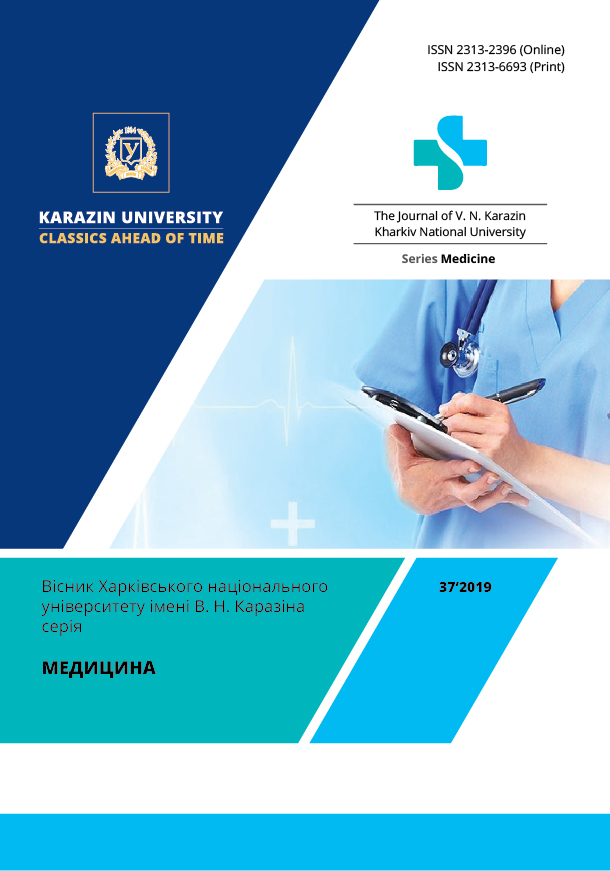Severe multiple trauma: analysis of multistage tactic of treatment
Abstract
Introduction. The main directions of intensive care in the acute polytrauma period are based on the principles of Damage control surgery, Damage control resusсitation, Damage control orthopedics. The purpose of work was to analyze the results of the diagnosis, treatment, surgical correction stages, deadlines final stabilization of bone fragments. Materials and methods. A retrospective study was carried out on history of 32 patients suffering from polytrauma which was accompanied by massive blood loss (30-40% deficiency of blood volume) and was characterized by combination of injuries. Clinical and laboratory parameters, stages according to Damage сontrol (DC) tactic, results of treatment were analyzed. Results. The results of diagnosis and treatment were analyzed in 20 (62.5%) males and 12 (37.5%) women, whose average age was 35.22 ± 12.7 years. The severity of injuries graded by the ISS scale was 26.84 ± 4.1. The level of consciousness by the GCS was 13,5 ± 0,5 points. In assessing the severity scale for patients with APACHE II was 14,97 ± 2,78 points. The degree of blood loss in the surveyed group corresponded to the III class according to the classification of the American college of surgeons and amounted to 35.21 ± 4.52% of the blood volume. Hemodynamic signs of hypovolemia were registered in all patients, and 25% needed vasopressor support. A total of 140 operations were performed in several stages. Оn the first day were performed 114 operations in order to stop the bleeding and temporary immobilization of the limbs. On the 2-14 days were performed 26 operations due to deferred indicators. Conclusion. this question need to further study of intensive care and development of criteria for the sequence and timing of multistage surgical correction in order to optimize treatment and reduce complications.
Downloads
References
Duchesne Juan C., Norman E. McSwain, Bryan A. Cotton et al. (2010) Damage Control Resuscitation: The New Face of Damage Control. J Trauma, 69, 976-990. https://doi.org/10.1097/TA.0b013e3181f2abc9.
Schnuriger Beat, Inaba Kenji, Barmparas Galinos at al. (2011) A New Survivable Damage Control Model Including Hypothermia, Hemodilution, and Liver Injury. Journal of Surgical Research, 169, 99–105. https://doi.org/10.1016/j.jss.2009.09.027.
Derek J. Roberts, Chad G. Ball, David V. Feliciano, Ernest E. Moore, et al. (2017) History of the Innovation of Damage Control for Management of Trauma Patients: 1902-2016 Annals of Surgery, 265(5), 1034-1044. https://doi.org/10.1097/SLA.0000000000001803.
S. F. Bagnenko, V. V. Stozharov, A. G. Miroshnichenko (2011) Organizacija i okazanie skoroj medicinskoj pomoshhi postradavshim v dorozhno-transportnyh proisshestvijah [Managing and providing emergency medical care to traffic accident victims]. Saint-Petersburg, 400. [in Russian].
Pape H. (2019) Damage-Control Orthopaedic Surgery in Polytrauma: Influence on the Clinical Course and Its Pathogenetic Background. European Instructional Course Lectures, G. Bentley, 9, 67–74.
Pape H., Rixen D., Morly J., et al. (2007) Impact of the Method of initial stabilization for femoral shaft fractures in patients with multiple injuries at risk for complications (Borderline patients). Annals of Surgery, 246(3), 491-501. https://doi.org/10.1097/SLA.0b013e3181485750.
Prin M. and Li G. (2016) Complications and in-hospital mortality in trauma patients treated in intensive care units in the United States, 2013. Injury Epidemiology, 3(18), 2–10. https://doi.org/10.1186/s40621-016-0084–5.
Advanced trauma life support: student course manual (9th ed) (2012) American College of Surgeons Committee on Trauma. – Illinois: American College of Surgeons, 366.
The Journal of V. N. Karazin Kharkiv National University, series Medicine has following copyright terms:
- Authors retain copyright and grant the journal right of first publication with the work simultaneously licensed under a Creative Commons Attribution License that allows others to share the work with an acknowledgement of the work’s authorship and initial publication in this journal.
- Authors are able to enter into separate, additional contractual arrangements for the non-exclusive distribution of the journal’s published version of the work, with an acknowledgement of its initial publication in this journal.
- Authors are permitted and encouraged to post their work online prior to and during the submission process, as it can lead to productive exchanges, as well as earlier and greater citation of published work.




